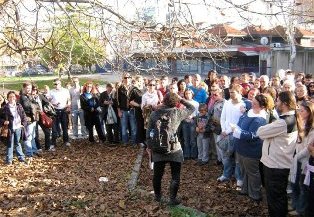The architectural heritage of the Ottoman Empire (1392-1912/13) left impressive monuments in Skopje, mostly visible in the old part of the city. These buildings suffered from the earthquake in 1555, the great fire from the Austrian general Piccolomini in 1689, as well as the fire in Skopje from 1910 and the disastrous earthquake in 1963. These monuments have been restored and rebuilt many times, and today, beside the status of monuments of culture, they have a new purpose in the cultural life of Macedonia.
Sultan Murat (Hunkar) Mosque – it is one of the oldest mosques in the Balkans (1436/37) as a foundation of Sultan Murat II. It stands on a hill, on the location of the middle age monastery. This complex also comprises of the Clock Tower (16th c.) and the mausoleums of Bikij Han (1556/57) and Ali Pasha of Dagestan (1774) (more info).
Ishak Bay (Aladza) Mosque – the name Aladza (1438/39) derived from the encrusted colorful ceramic tiles ornamenting the facade and the drum of the mosque. The complex hosts hexagonal turbe (15th c.), one of the rarest in the Balkans and famous with the wall in which colorful faience tiles are embedded, creating six pointed stars (more info).
Gazi Issa Bay Mosque – constructed as a memorial after the death of its founder Issa Bay (1475/76), the mosque has two domes covered with steel and the adorable walls were built of trimmed tartar stones with layers of bricks. Next to the mosque a plane tree (Platanus Orientalis) can be found, that is as old as the mosque itself (more info).
Mustapha Pasha Mosque – erected in 1492, at the entrance there is a porch supported by four columns, and the main part has a square plan covered with a dome. The minaret is 60 m high. Inside the complex there is a turbe, the grave of the founder Mustafa Pasha himself and a richly decorated sarcophagus of his daughter Uma (more info).
Bezisten – built in the 15th century, the covered bazaar can be entered through four gates. Solely it was a place for selling clothes. It gained its name since ‘bezz’ means clothes in Arabic, and ‘i-stan’ means a selling place in Persian. Today, it is a pleasant venue with art galleries, stores and cafés (more info).
Chifte Hammam – built in the 15th as a public bath, the word “chifte” in Turkish means double, because the two separated wings served one for men and one for women. Today it is part of the National gallery of Macedonia and hosts a lot of exhibitions (more info).


Vasilka Dimitrovska (co-founder of HAEMUS), archaeologist and trainer in heritage interpretation, is guiding visitors at the Skopje’s кülliye (left) and Mustafa Pasha mosque (right)
Kapan Inn – built in the 15th century, it served for accommodation of tradesmen and their caravans as well as for travellers. Today it hosts a lot of restaurants, cafe bars and Turkish tea houses (more info).
Suli Inn – built in the 15th century, it has two floors, with the upper having rooms for the guests and the lower for the guests’ cattle. The rooms are lined around the square-shaped interior courtyard. Suli An today houses the Academy of Art and the Old Bazaar Museum (more info).
Kurshumli Inn – built in 15th century, it served as an inn to merchants and their caravans. The roof of the inn was once covered in lead (hence the name kursunlu). Now it houses the Lapidarium of Museum of Macedonia and it is also a popular concert venue (more info).
Daut Pasha Hammam – public bath (1468-1497) with a square plan and 15 rooms, roofed with two big symmetrical and 11 smaller domes. Today this hammam is part of the National gallery of Macedonia and hosts the exhibition of Macedonian contemporary art. (more info).
Skopje’s кülliye – a term which designates a complex of buildings, centered around a mosque and managed within a single institution, often based on a vakıf (foundation), and composed of a medrese, a darüşşifa, kitchens, bakery, hammam, other buildings for various benevolent services for the community and further annexed constructions.
Stone Bridge – the landmark of Skopje and one of the oldest bridges in Macedonia, representing a connection between the old and the new part of the city. According to certain data there is different information about the time of its construction, 6th century AD or the first half of the 15th century (more info).
The Ottoman period of the Skopje Fortress – located in the centre of the city, the fortress is a dominant landmark, offering a view to the old and the new parts of Skopje. It is one of the most complex archaeological sites that were inhabited from prehistory to the middle of 20th century. The artifacts from this excavation are displayed in the City Museum of Skopje (more info).


